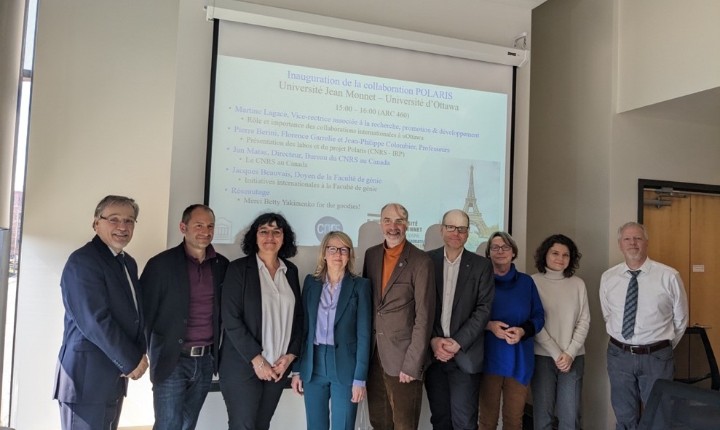Inauguration of the CNRS Polaris International Research Project
Inauguration of Polaris at the Advanced Research Complex of the University of Ottawa, 20th April 2023.
Left to right :
François Carrier (Director, International Research and Experiential Learning at uOttawa),
Jean-Philippe Colombier (Professor, Laboratoire Hubert Curien),
Florence Garrelie (Director, Laboratoire Hubert Curien),
Martine Lagacé (Associate vice-president, research, promotion and development at uOttawa),
Jacques Beauvais (Dean of the Faculty of Engineering at uOttawa),
Jan Matas (Director, CNRS Office in Canada),
Carmen Bauer (Senior Project Officer, Office of International Research and Experiential Learning at uOttawa),
Olga Golovachova (Manager, International Affairs for the Faculty of Engineering at uOttawa),
Pierre Berini (Director, Photonics Research Centre uOttawa).
© Arthur Roullin / CNRS
The Laboratoire Hubert Curien and the Photonics Research Centre of the University of Ottawa (CRPuO) have recently inaugurated a collaborative project initiated in 2018, in the form of a new CNRS International Research Project (IRP, formerly known as LIA - Laboratoire International Associé). The collaboration aims to develop state-of-the-art research on photonics for surface and materials engineering, in a top-down application-oriented approach in the fields of sensors, energy and security.
The project is coordinated by our Laser-Matter Interaction team member Jean-Philippe Colombier for the French side, and Pierre Berini for the CRPuO. Both partners are combining their respective skills to develop a better understanding of the modification and control by light of a surface’s functionalities.
This form of joint laboratory is the first to be created in our University, and constitutes one of the tools put in place by the CNRS to encourage and help researchers organize collaborations between its research units and leading laboratories around the world.
Responding to a variety of societal challenges through the manufacture of surfaces by action of light, the two labs have committed to the establishment of a creative and multidisciplinary research and innovation field, in support of surface engineering. The project is structured around 4 axes, involving 3 different teams within our lab (Laser Matter Interaction, Functional Materials & Surfaces, MOPERE), each working on a specific subject but all seeking scientific and societal results:
- Light as a manufacturing process - Structural and chemical surface functionalization by ultrashort laser pulses;
- Light as a means of ultra-rapid diagnosis - Observation and simulation of the dynamics of matter with sub-femtosecond resolution;
- Light as a means of detection - Development of plasmonic biosensors by surface photolithography and magneto-optical modulation;
- Light for communication purposes - Development of fiber optic sensors for severe environments.
POLARIS extends five years of productive scientific collaboration between the two laboratories. “Since 2018, several joint scientific development areas have been identified, based on the recognised expertise of the two labs in surface engineering, the ultrafast dynamics of ultrashort laser processes, the modelling of laser-matter interaction, plasmonics, sensors for harsh environments and 3D optical systems,” says our lab Director Florence Garrelie.
The CNRS IRP status of the project will facilitate student mobility between the two laboratories, extend the jointly supervised PhD program that has already been initiated, and lead to several scientific publications in international conferences and journals.
The CRPuO being undoubtedly one of the most important Canadian research center in optics/photonics and one of world’s leading in the field, the Laboratoire Hubert Curien is proud to have established such a partnership.

